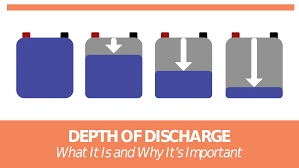1. What is Depth of Discharge (DOD)?
Depth of Discharge (DOD) is a key metric used to measure the amount of energy discharged from a battery during use, typically expressed as a percentage. For example, a battery with a nominal capacity of 100Ah, when discharged by 80Ah, would have a DOD of 80% (DOD = 80%). In simple terms, DOD reflects the proportion of energy released by the battery during one cycle relative to its total capacity.

2. Why is DOD So Important for Batteries?
DOD is closely linked to battery life, performance, and safety:
-
Cycle Life: The higher the DOD, the more energy the battery releases per cycle, but it will significantly shorten the total number of cycles. For example:
- A lead-acid battery at 50% DOD can last 1200 cycles, while at 100% DOD, it might only last 300 cycles.
- A lithium battery at 80% DOD typically lasts 2-3 times longer than at 100% DOD.
-
Capacity Degradation: High DOD accelerates the internal chemical reactions of the battery, causing active material degradation and permanent capacity loss.
-
Economics: Properly controlling DOD can reduce battery replacement frequency and lower the long-term operating costs of energy storage systems or electric devices.
3. Typical Applications of DOD
Different applications have varying requirements for DOD:
-
Electric Vehicles: To balance range and battery life, most electric vehicles control DOD to 80%-90%, avoiding complete discharge.
-
Home Energy Storage Systems: Recommended DOD is 60%-80%, balancing daily energy needs and battery longevity.
-
Consumer Electronics (e.g., smartphones): Lithium-ion batteries usually default to a 100% DOD, but frequent deep discharges can accelerate aging.
-
Industrial Energy Storage (e.g., grid-scale): DOD is strictly controlled between 50%-70% to extend system life to over 10 years.
4. How to Optimize DOD to Extend Battery Life?
-
Set Reasonable Charge/Discharge Thresholds:
- Lead-acid batteries: DOD ≤ 50%.
- Lithium batteries: For daily use, DOD ≤ 80%; for long-term storage, maintain 50% charge.
-
Use an Intelligent BMS (Battery Management System): The BMS monitors voltage, temperature, and SOC (State of Charge) in real-time, dynamically adjusting charge/discharge strategies to prevent deep discharge.
-
Choose the Right Battery Type:
- Lithium Iron Phosphate (LFP): Tolerates higher DOD (80%-90%), suitable for frequent charge/discharge scenarios.
- NCM/NCA Lithium Batteries: Recommended DOD ≤ 80%, focusing on energy density.
-
Control Operating Temperature: High temperatures exacerbate the damage caused by high DOD. Maintaining an environment between 15°C-35°C helps slow down aging.
5. Frequently Asked Questions (FAQ) About DOD
Q1: What’s the difference between DOD and SOC?
- SOC (State of Charge): Represents the remaining charge in a battery (e.g., SOC = 20% means 20% charge remaining).
- DOD: Represents the percentage of energy discharged (e.g., DOD = 80% means 80% of energy has been used). The relationship is: DOD = 100% - SOC.
Q2: Does 100% DOD cause permanent damage to the battery?
Yes. Regular full charge and full discharge (especially in lithium batteries) can damage the electrode structure and accelerate capacity loss. Occasional full discharge may have minor effects, but frequent deep discharges should be avoided.
Q3: How can DOD be measured?
DOD can be measured using real-time monitoring of voltage, current, and capacity integration by the BMS or specialized equipment such as battery capacity testers.
6. Conclusion
Depth of Discharge (DOD) is an important parameter for assessing the intensity of battery use, directly affecting device longevity, cost, and sustainability. Properly controlling DOD, selecting suitable battery technologies, and utilizing intelligent management systems can significantly extend battery life. Whether in electric vehicles, energy storage systems, or daily electronic products, scientific DOD management can offer users a more efficient and cost-effective energy usage experience.

